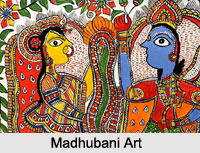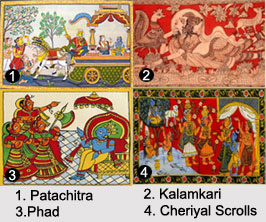 Folk Arts of India are quite well developed. They are different from primitive art forms in which they are more finished, polished, complex and stylised. Folk art came after the village settlements were established. It is marginally developed and more finished in nature. The common people are the mainspring of folk art.
Folk Arts of India are quite well developed. They are different from primitive art forms in which they are more finished, polished, complex and stylised. Folk art came after the village settlements were established. It is marginally developed and more finished in nature. The common people are the mainspring of folk art.
Folk art forms may accompany the celebration of various religious, social and family festivals. The problem of fertility both in case of human beings and land, the problem of natural disasters like floods, famines and fire, diseases and accidents, directly or indirectly, provide the theme for folk art. The main purpose of folk arts is three-fold; which satisfy people`s passion for religious rituals, entertainment as well as social interaction.
Features of Folk Arts in India
Folk arts, as distinct from tribal art and traditional art, exhibit certain characteristics which are typical to this art form alone. The compositions either do not claim any author or are adopted from written texts. But neither the performers nor the audience are interested in the source of the text or the author. Folk art is mostly orally transmitted and passes from generation to generation through Guru-Sishya Parampara. The folk arts have no watertight compartmentalisation among themselves and there is seen a mixture of dance, song, music and drama.
The division into dance, drama and musical forms made basing on emphasis. The music used in the folk arts is mostly Bhava-centric music. The stress is on Tala (rhythm) and though all kinds of instruments are used, the most important instruments used are percussion instruments. Most common kinds of Anabadha (drum) Vadyas are Dhol, Mardal, Khol, Pakhavaj etc. The Ghana (brass) instruments are Gird, Jhanja, Kartal etc. A particular feature of folk art is the presence of body language and histrionics even where no actual dramatic plot exists.
Types of Folk Arts in India
Earliest Indian folk painting and art styles have been passed down from invention to generation and are still practised in diverse parts of the country. Following are the main types of folk arts of India:
Miniature Paintings: Initiated in the Mughal period, about 16th century, Miniature paintings are inclined by Persian styles and prospered under Shah Jahan and Akbar`s regulation. These paintings are symbolized by its miniature size but elaborate details and delicate expressions.
Madhubani: It is one of the most popular Indian folk arts, practiced mostly by women who wanted to be one with God. It is also called Mithila art; it initiated in the kingdom of Janak in Nepal and in there-day Bihar.
 Patachitra: It was originated from the 5th century in religious hubs like Puri and Konark. It is a cloth-based scroll painting from Odisha and West Bengal.
Patachitra: It was originated from the 5th century in religious hubs like Puri and Konark. It is a cloth-based scroll painting from Odisha and West Bengal.
Warli: This is simply one of the oldest art forms of India. It was initiated by the Warli tribes from the Western Ghat of India. All the paintings are done on a red yellowish-brown or dark background, while the shapes are white in colour.
Phad: Phad is mainly a religious form of scroll painting depicting folk deities Pabuji or Devnarayan. The 30- or 15 feet-long canvas or cloth that it is painted on is called phad. It was originated in Rajasthan.
Gond: The colours come from charcoal, cow dung, leaves and coloured soil. The Gondi tribe in Madhya Pradesh produced these bold, brightly coloured paintings, depicting mostly flora and fauna.
Kalamkari: There are two types of Kalamkari in India; Machilipatnam which initiates from Machilipatnam in Andhra Pradesh and Srikalahasti. Kalamkari art is used on sarees and cultural clothing and portrays everything from flora and fauna to epics such as Mahabharata or Ramayana.
Tanjore: Tanjore or Thanjavur paintings initiated in 1600 AD. These pane paintings on wooden planks portray devotion to gods, goddesses and saints.
Cheriyal Scrolls: This vanishing art form is followed by the Nakashi family only. These 40-45 feet scrolls were a necessary visual complement as saints wandered around singing or narrating the epics which depicts puranas and epics.
Kalighat Paintings: It originated in the 19th century Bengal, from Kalighat. These paintings, on cloth and pattas portrayed Gods and Goddesses but then took a turn headed for social improvement.
Batik: Batik arts also constitute a significant form of folk arts in the nation. Artists like Ganga Devi have contributed largely to the different types of folk arts in India.
Other interesting folk arts found here are the Rajasthani paintings, Tanjore paintings, Kalamajhethu and Alpana floor creations, Tibetan Scrolls, `Bandhani` print work, glass painting and numerable others.



















